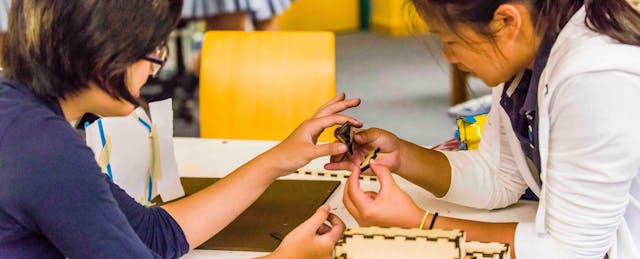As the director of a maker lab at Castilleja School, an independent all-girls school for grades 6-12, I, along with my team, have witnessed dramatic changes in skills and confidence that can occur when we give young women not only the opportunity but also a safe space to make, build, tinker, and create. In line with multiple articles calling for empowering a more diverse and inclusive community of makers, we strongly believe that maker programs and inclusive maker spaces are particularly important in girls’ education.
Why Are Girls Less Interested in STEM?
According to a 2010 research report by the American Association of University Women titled “Why So Few? Women in Science, Technology, Engineering, and Mathematics”, girls generally have more difficulty acquiring spatial thinking and reasoning skills than boys due to the type of play they engage in as children. Since many STEM fields rely heavily on spatial skills especially in advanced studies, this puts young women at a significant disadvantage compared to their male peers. In that same report, however, the authors noted that there is also clear evidence that consistent exposure at a young age to activities that promote spatial skills, even activities as simple as taking things apart and putting them back together, can alleviate this imbalance and attract more girls to STEM studies.
Castilleja School’s Bourn Idea Lab
To provide opportunities for girls to immerse themselves in the types of hands-on activities that will increase their self-confidence in spatial thinking, Castilleja School, located in Palo Alto, CA, transformed a seldom-used student lounge into the Bourn Idea Lab four years ago. Named after a former robotics mentor who dedicated countless hours to our FIRST Robotics team, the Bourn Lab was designed to be more than just a robotics and engineering lab. It is a tinkering studio for the entire school, outfitted with a collection of digital fabrication equipment, traditional shop tools, electronics gadgets, and a wide variety of materials that cater to makers of all sorts.
Because Castilleja is committed to preparing young women to be self-directed learners and independent leaders through experiential hands-on learning, the Bourn Lab fits easily and naturally into the philosophy and mission of the school. In addition to the space itself, we also intentionally designed the lab’s program with two complementary goals in mind. The first is to give ALL students, whether they identify themselves as "techie" or not, the opportunity to solve open-ended problems and gain experience in making and tinkering. To do so, my team and I collaborate with teachers of various grade levels and disciplines to integrate hands-on projects into the core subjects, such as building prototypes of da Vinci machines in history and using robotics kits to construct and program interactive kinetic sculptures in art class. In order to give students a diverse range of experiences, we design both teacher-driven activities that focus on skills (e.g. learning 3D design in geometry) and student-driven projects that focus on practice with open-ended prompts and the design process (e.g. building interactive museum exhibits in biology).
Encouraging STEM Confidence in Young Women
The second goal of the lab is to foster engineering education and give more young women the confidence needed to pursue STEM fields. To this end, we provide “opt-in” opportunities for students who show further interest through engineering electives, Maker Fridays (open lab hours where students can use the lab for personal projects), independent study courses, and of course, participation in our robotics programs.
The Advantages of an All-Girls Maker Environment
Since Castilleja is an all-girls school, we are very fortunate to already have one fewer barrier in the way of getting our students to participate in the lab: the very real pressures of a coed environment. Not long ago, we hosted a coed group of student visitors in the Bourn Lab during an engineering class when we were building Lego vehicles to learn about how gearing affects speed and torque. On one side of the lab, Castilleja girls were working in teams with every student actively engaging in the project, contributing her ideas, and helping out her team in some way. In contrast, on the other side of the lab, our visitors quickly self-organized such that the boys crowded around the table of Legos, jostling each other for parts and eagerly trying out their own ideas. The girls in our visitor group, on the other hand, stood on the periphery, unwilling to push their way into the fray. When the teachers intervened and offered to put them at a different table away from the boys, they politely declined the offer and said that they preferred to just watch their male peers. That day, we were reminded again of the benefits of an all-girls environment, particularly when it comes to activities that still seem to be dominated by men.
We urge other educators to consider this option, perhaps by offering girls-only workshops or open hours, if they too observe a major gender imbalance in their own maker spaces. The challenge really is to create maker spaces that not just welcome girls, as many spaces already do, but actually feelwelcoming to girls. The goal is to provide a safe, inclusive space where young women can build skills and gain self-confidence in their own abilities as makers, designers, engineers. Whether they continue further down this path later on in life is not up to us as their teachers; whether they start walking on this path and peek curiously at the sights along the way, however, is.


